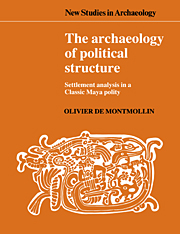Book contents
- Frontmatter
- Contents
- List of figures
- List of tables
- Preface
- 1 Studying ancient complex polities
- 2 Thinking about Maya political structure
- 3 The Rosario polity
- 4 Linking Maya politics and settlement
- 5 Centralization
- 6 Differentiation and integration
- 7 Political regimes and microcosms
- 8 Political stratification patterns
- 9 Mechanical versus organic solidarity
- 10 Segmenting versus non-segmenting organization
- 11 Archaeological study of Maya polities
- Notes
- References
- Index
2 - Thinking about Maya political structure
Published online by Cambridge University Press: 29 March 2010
- Frontmatter
- Contents
- List of figures
- List of tables
- Preface
- 1 Studying ancient complex polities
- 2 Thinking about Maya political structure
- 3 The Rosario polity
- 4 Linking Maya politics and settlement
- 5 Centralization
- 6 Differentiation and integration
- 7 Political regimes and microcosms
- 8 Political stratification patterns
- 9 Mechanical versus organic solidarity
- 10 Segmenting versus non-segmenting organization
- 11 Archaeological study of Maya polities
- Notes
- References
- Index
Summary
Societal typologies
An effective study of political structure and organization in ancient complex polities cannot go very far without a good initial conceptualization of such polities. Societal typologies or bundled continua of variation are two principal approaches to meeting this requirement. Along with other Americanist archaeologists, students of Maya politics have usually opted for the first approach. There are numerous attempts to classify Maya sociopolitical systems as belonging to one or another societal type. Some have tried to decide whether the Maya had theocratic as opposed to secular-militaristic government (Wolf 1959; Webster 1976a). Contrasts are drawn between theocratic (lowland) Maya and secular-militaristic (highland) Central Mexican cultures or between the theocratic Classic Maya and the secularmilitaristic Postclassic Maya. Others have adopted a cultural-evolutionary typology (Service 1971), discussing whether the Maya had a chiefdom or a state level of development, and trying to determine when and why the shift from one to the other might have occurred (Sanders and Price 1968; Marcus 1976). Whether the Maya had an urban or non-urban form of civilization has also intrigued Mayanists (Haviland 1966a; Kurjack 1974) as has the question of whether the Maya had egalitarian, ranked, or stratified social structure (Rathje 1973; Haviland 1966b; Vogt 1983). An energy-capture view of cultural evolution has been used to categorize the Classic Maya as a Low Energy Society, contrastable with High Energy Societies in Central Mexico (Sidrys 1978). Other studies have placed the Maya in a Durkheimian typological framework, contrasting the Maya's mechanically solidary socioeconomic system with organically solidary socioeconomic systems and contrasting societas with civitas (Coe 1961, 1965).
- Type
- Chapter
- Information
- The Archaeology of Political StructureSettlement Analysis in a Classic Maya Polity, pp. 11 - 39Publisher: Cambridge University PressPrint publication year: 1989



